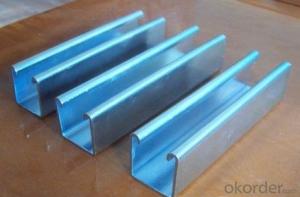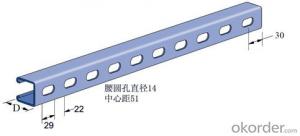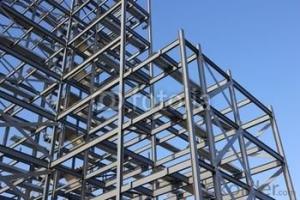stress components -- type steel and fastener (with locking serrations)
- Loading Port:
- Tianjin
- Payment Terms:
- TT OR LC
- Min Order Qty:
- 50 m.t.
- Supply Capability:
- 12000 m.t./month
OKorder Service Pledge
OKorder Financial Service
You Might Also Like
The professional good coordination, improve indoor space elevation
Has good compatibility, the professional can share a hanger; make full use of space, can make each professional bundles can be good coordination.
- force, stable and reliable
Design and construction of atlas and complete, all the stress components -- type steel and fastener (with locking serrations) can realize the assembly components of a rigid mating,connecting without displacement, no order adjustment, accurate positioning. Shock and vibration, enhance the shear resistance capacity of bracket nodes.
And tracking services, real-time guidance, doubts on the construction site
Technical personnel at the scene guidance, FAQ, do mechanics analysis in real-time tomeet in the construction of the special support and hanger, and the coordination of various professional bundle
And fast installation, short construction period
The installation speed is 6~8 times of traditional practices, in reducing the cost ofmanufacture and installation of 1/2. All professions and trades cross operation, improve work efficiency, shorten the construction period.
And long service life, convenient maintenance
The use of the environment, according to special requirements of customers, provide different process materials are electric galvanized (Leng Duxin), hot dip galvanized andgalvanized coating powder (spray)
Quasi - materials budget
Ensure the products for the standardization of semi-finished products, model identificationwith clear, standardized management, materials and the fittings on the waste and loss ofrare.
And excellent quality assurance
With ISO9000, ISO9002 standard, ensure the stability of the whole system integrity andhanger.
Good generality
And the combination of standard component types of rich, available options. Ensure all kinds of support under different conditions, simplicity, applicability and flexibility.
And environmental protection
Construction without welding and flame, will not impact on the environment and office.
Our factory has ten fully automatic and semi automatic cold bending production line eight,has its own development team, the independent development of mold design to meet the various needs of customers. Product appearance, size precision, reasonable design,convenient use saves the massive manpower and physical for customers, reducing the cost, the products are widely used in the construction industry, automobile manufacturing,solar power generation, machinery manufacturing, power transmission tower, bridge, shipmilitary aviation industry, railway and highway construction, machine room equipmentcontainer, mineral support etc.. The best-selling products, well received by customers. This is a company won the trust of customers, has broad prospects for development of theenterprise.
Z type steel main points: equilateral Z type steel, galvanized Z type steel, solar stent type Zsteel, the major and medium small type Z steel, Z shaped steel purlin, template supportoverlapped Z type steel Z steel, Z steel, such as automobile profiles, the above specifications for factory main products, such as shape, specifications, drawings can betransfer to my company.
- Q:How does steel compare to other construction materials, such as concrete or wood?
- Steel is a highly versatile and durable construction material that offers several advantages over other materials like concrete or wood. It has a superior strength-to-weight ratio, making it ideal for constructing large structures and high-rise buildings. Steel also possesses excellent resistance to fire, corrosion, and pests, providing long-term durability and reducing maintenance costs. Additionally, steel structures can be easily modified or expanded, making them more adaptable to changing needs. While concrete and wood have their own advantages, steel's unique properties make it a preferred choice for many construction projects.
- Q:How do steel structures contribute to the overall acoustic performance of a building?
- Enhancing a building's overall acoustic performance can be achieved through the use of steel structures. The inherent rigidity and stability of steel play a key role in this regard. Steel is a strong material that efficiently transfers sound vibrations, thereby minimizing noise transmission between different areas of a building. The incorporation of steel in load-bearing elements, like beams and columns, ensures excellent structural integrity. This rigidity helps reduce vibrations caused by external factors (e.g., traffic, heavy machinery) and internal sources (e.g., footsteps, mechanical equipment). Consequently, steel structures effectively decrease noise levels within a building. Furthermore, steel structures can be designed to include various acoustic treatments and barriers. For instance, steel panels or walls can be utilized to create sound insulation, preventing the transmission of sound waves between spaces. These panels can be combined with specialized insulation materials to further enhance the soundproofing capabilities of the steel structure. Moreover, steel structures provide flexibility in the design and placement of acoustic elements such as panels, diffusers, and absorbers. These elements can be strategically integrated into the steel framework, ensuring optimal sound diffusion and absorption throughout the building. By controlling the reflection, diffusion, and absorption of sound waves, steel structures contribute to a balanced and pleasant acoustic environment. Additionally, steel structures offer long-term durability and stability. Unlike other materials, steel does not degrade or warp over time, maintaining its acoustic performance for extended periods. This ensures that a building's acoustic characteristics remain consistent and reliable, even after years of use. To summarize, steel structures contribute to a building's acoustic performance by providing rigidity, stability, and the ability to incorporate various acoustic treatments. These features minimize sound vibration transmission, enhance sound insulation, and allow for the integration of acoustic elements. By utilizing steel in construction, architects and engineers can create buildings that offer improved acoustic comfort, reduced noise levels, and an overall enhanced user experience.
- Q:How are steel structures designed for efficient waste water treatment systems?
- Due to their durability, strength, and versatility, steel structures are often the preferred choice for constructing efficient waste water treatment systems. When designing these structures, several factors are taken into account to ensure optimal waste water treatment. To begin with, the design takes into consideration the specific requirements of the waste water treatment process. Each treatment system has its own unique needs, such as the space required for treatment units, necessary equipment, and flow dynamics within the structure. Steel structures can be easily customized to accommodate these requirements, resulting in improved performance and efficiency. Another important aspect in the design of steel structures for waste water treatment systems is corrosion resistance. Waste water often contains corrosive chemicals and contaminants. To combat this, steel structures can be coated with specialized materials like galvanized steel or epoxy coatings, which protect against corrosion. This extends the lifespan of the structure and reduces maintenance needs. Moreover, steel structures are designed to be sturdy and stable. Waste water treatment systems involve handling large volumes of water and equipment, which can exert significant loads on the structure. The inherent strength of steel allows for the construction of robust frameworks that can withstand these loads without deforming or failing. This structural stability is essential for the smooth operation and long-term efficiency of the treatment system. Additionally, steel structures can be prefabricated off-site, providing several advantages. Prefabrication enables faster construction times, reducing project timelines and costs. It also ensures a higher level of quality control as components are manufactured in controlled factory conditions. This precise manufacturing process guarantees seamless fitting of the steel structure, enhancing the efficiency of the waste water treatment system. In conclusion, steel structures are designed to create efficient waste water treatment systems by considering specific requirements, incorporating corrosion-resistant coatings, ensuring structural stability, and utilizing prefabrication techniques. These design considerations result in robust, durable, and efficient waste water treatment systems that effectively remove contaminants and protect the environment.
- Q:What are the different types of architectural finishes used in steel structures?
- Some common types of architectural finishes used in steel structures include paint coatings, galvanization, powder coating, and cladding materials such as aluminum or glass. These finishes not only enhance the aesthetic appeal of the structure but also provide protection against corrosion and weathering.
- Q:How are steel structures used in cold storage facilities?
- Cold storage facilities rely on steel structures for their durability, strength, and versatility. Not only are steel frames used for the construction of the facility, but steel is also incorporated into various components and equipment within the facility. The use of steel allows for large open spaces without the need for excessive support columns or walls, maximizing storage capacity. Steel is also used in refrigeration systems, piping, support beams, and shelving systems, ensuring durability and safety. Additionally, steel structures can be easily modified, expanded, or relocated, providing flexibility for future growth or changes in storage requirements. Steel structures offer superior resistance to fire, pests, and environmental elements, making them ideal for cold storage facilities. Overall, the use of steel structures in cold storage facilities provides numerous benefits, including efficient space utilization, adaptability, and safety. These structures are essential in maintaining the integrity of the facility and preserving the quality of perishable goods by creating a controlled environment with consistent low temperatures.
- Q:How are steel structures designed to withstand heavy loads?
- Steel structures are designed to withstand heavy loads through a combination of factors. Firstly, the structural members, such as beams and columns, are made from high-strength steel which possesses excellent load-bearing capacity. Additionally, engineers carefully calculate the dimensions, size, and layout of these members to optimize their load-carrying capacity and minimize stress concentrations. Furthermore, steel structures often incorporate bracing systems, such as diagonal braces or shear walls, to enhance their overall stability and resistance against heavy loads. Lastly, advanced computer-aided design software is employed to simulate and analyze the behavior of the structure under different load scenarios, ensuring its safe and efficient performance.
- Q:How are steel structures designed for efficient use of water resources?
- Steel structures can be designed to promote efficient use of water resources in several ways. Firstly, steel is a highly durable material that can withstand harsh weather conditions and has a long lifespan. This means that steel structures require less maintenance and repair, reducing the need for water-intensive activities such as cleaning and painting. Additionally, steel structures can incorporate rainwater harvesting systems, which collect and store rainwater for various purposes. This water can be used for irrigation, flushing toilets, or even for industrial processes within the structure. By utilizing rainwater, steel structures can reduce their reliance on freshwater sources, ultimately conserving water resources. Furthermore, steel structures can be designed with efficient plumbing systems that reduce water wastage. Low-flow fixtures, such as faucets and toilets, can be installed to minimize water consumption without compromising functionality. Additionally, leak detection systems and water-efficient irrigation systems can be integrated into the structure's design to prevent water leaks and optimize irrigation practices. Moreover, steel structures can be designed with green roofs or rooftop gardens, which help reduce the heat island effect and improve stormwater management. These green features help to retain rainwater, reducing runoff and allowing for natural filtration before it enters water bodies. This promotes sustainable water management and reduces the strain on municipal water systems. In conclusion, steel structures can be designed to maximize the efficient use of water resources through various strategies such as rainwater harvesting, efficient plumbing systems, green roofs, and water-efficient irrigation systems. By incorporating these design elements, steel structures contribute to water conservation efforts and promote sustainable water management practices.
- Q:How are steel structures designed to accommodate natural lighting?
- Steel structures can be designed to accommodate natural lighting through several methods. One common approach is incorporating large windows or transparent panels in the walls or roof of the structure to allow sunlight to penetrate into the interior spaces. Additionally, skylights or clerestory windows can be installed to bring in natural light from above. These design choices not only provide ample daylight but also reduce the need for artificial lighting, resulting in energy savings and a more sustainable building.
- Q:How are steel structures designed for mixed-use developments?
- Steel structures for mixed-use developments are designed by considering the specific requirements of various functions within the development. This includes analyzing the load-bearing capacity, spatial arrangements, and flexibility needed for commercial, residential, and other purposes. Steel's strength, durability, and versatility allow for efficient design solutions that can accommodate a range of uses while ensuring structural integrity and safety. The design process involves collaboration between architects, engineers, and developers to achieve an optimal balance between aesthetics, functionality, and cost-effectiveness.
- Q:How do steel structures compare to concrete structures in terms of strength?
- Steel structures are generally stronger than concrete structures. Steel has a higher tensile strength, which means it can withstand greater stress or pulling forces without breaking. Concrete, on the other hand, has a higher compressive strength, making it better at withstanding compression or pushing forces. However, when it comes to overall strength, steel structures have the advantage due to their ability to resist both tension and compression forces effectively.
1. Manufacturer Overview |
|
|---|---|
| Location | |
| Year Established | |
| Annual Output Value | |
| Main Markets | |
| Company Certifications | |
2. Manufacturer Certificates |
|
|---|---|
| a) Certification Name | |
| Range | |
| Reference | |
| Validity Period | |
3. Manufacturer Capability |
|
|---|---|
| a)Trade Capacity | |
| Nearest Port | |
| Export Percentage | |
| No.of Employees in Trade Department | |
| Language Spoken: | |
| b)Factory Information | |
| Factory Size: | |
| No. of Production Lines | |
| Contract Manufacturing | |
| Product Price Range | |
Send your message to us
stress components -- type steel and fastener (with locking serrations)
- Loading Port:
- Tianjin
- Payment Terms:
- TT OR LC
- Min Order Qty:
- 50 m.t.
- Supply Capability:
- 12000 m.t./month
OKorder Service Pledge
OKorder Financial Service
Similar products
New products
Hot products
Hot Searches
Related keywords






























